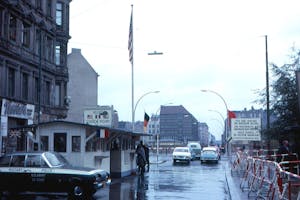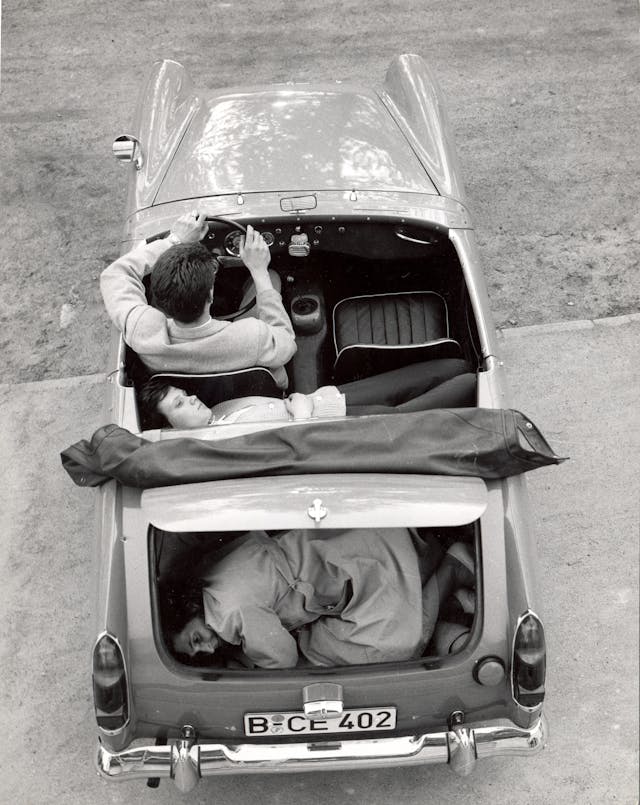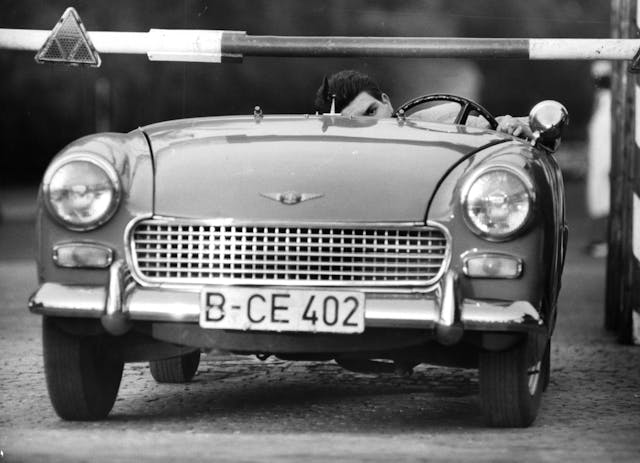This Austin-Healey Sprite escaped East Germany—twice
It was an off-hand question, but one loaded with fear and tension. As the East German border guard flipped through Norbert Konrad’s passport, he asked, “Isn’t this the same type of car one man used to get through the barriers?” Konrad answered that he didn’t know. But he was lying. A little Austin-Healey Sprite had already slipped past the Iron Curtain once. A Sprite would do so again.
On 13 August 1961, troops and workers of the communist German Democratic Republic (GDR) started to tear up roads and raise barbed-wire fences, closing the border between East and West Berlin. The first concrete pieces were placed four days later, the first blocks in the wall that would come to embody the simmering divisions between the western world and the Soviet Bloc.
The Berlin Wall was eighty-seven miles long. Together with the main structure, a secondary fence enclosed a no man’s land in between, and the entire structure was heavily guarded by troops with orders to shoot to kill. The GDR scattered Stasi secret police agents among these troops to ensure every man followed orders. “Don’t hesitate to use your weapon even when border breaches happen with women and children,” a declassified document reads.
Nevertheless, people desperate to flee the grip of East Germany still tried to escape. At least 140 people were killed at the wall itself, and over a thousand across the internal German border. Some yearned for a better life in the West. Some hoped to avoid conscription. Others were trying to fulfill a forbidden love.
As an Austrian citizen, young engineer Hans Meixner was able to cross between the two Berlins at the infamous Checkpoint Charlie. He was working as a lathe operator in West Berlin, but could travel back and forth across the border on a tourist visa. At a student dance in East Berlin, he had met and, eventually, fallen in love with Margarete Thurau.

The couple got engaged and applied through the official channels for permission for Margarete to move to Austria. The GDR police told Margarete that it would be far better for the pair to settle in East Germany. Permission to cross the border would not be forthcoming, so Meixner began plotting to get her out.
People had used cars to escape East Germany before, hiding under false floorboards, clinging to the underside of a car or, in one memorable case, stowed away inside the engine compartment of a modified BMW Isetta. However, the GDR border guards usually searched cars thoroughly, and the chance of discovery and capture were too high.
Meixner had another problem. He didn’t have to smuggle just one person out of East Germany; he had to extract Mrs. Thurau, Margarete’s mother. He needed a car that could carry two concealed passengers and, somehow, sneak through a barrier designed—and ruthlessly guarded—to keep people from escaping.

Happily, he had spotted a flaw in the East German checkpoint. The lifting barrier between the two Germanies wasn’t entirely solid—it had a gap beneath it. Crossing to East Berlin on his scooter, he pretended to stall right next to the barrier and surreptitiously measured that gap while appearing to fiddle with the engine. The gap was 37.5 inches high.
Enter the Austin-Healey Sprite. Introduced in 1959 as a low-cost sports car small enough to be stuffed into a bike shed, the first Sprite is one of the most cheerful-looking cars ever made. The second-generation “square-body” car was much more conventional in appearance, but it was still tiny. It stood 48.25 inches high with the roof up—or, with the windshield removed, 35.5 inches high. Two inches to spare.
Meixner found a Sprite at a rental car agency and crossed into East Berlin. On May 17, 1963, just after midnight, he helped his fiancée and future mother-in-law cram themselves into, respectively, the parcel shelf and trunk of the Sprite, removed its windshield, and headed for the border. As added insurance, he tucked some bricks into the rear of the trunk to stop any bullets that the border guards might send their way.
The guard who checked his passport was immediately suspicious. Why was Meixner driving with no roof on such a chilly day? He was waved over to the customs point for a full search.

Instead, Meixner drove slowly onwards, then gunned the engine, twisting the Sprite through the slalom barricades, and then went full throttle, straight on towards the barrier. The guards, caught by surprise, simply gaped after him as he rocketed past. He ducked down, and the little car limbo’d right under the barricade to freedom.
On the Western side, Meixner locked up the brakes and left a 96-foot skid mark. The West Berlin police were surprised but impressed, and news of the escape spread quickly.

Two months later, an Argentinian named Norbert Konrad found himself in a similar predicament. He’d heard about Meixner’s escape so he, too, rented an Austin-Healey Sprite and headed East to help his fiancée escape.
Konrad didn’t know it at the time, but the Healey he was driving wasn’t just the same type of car; it was the exact same Sprite that Meixner had rented. Konrad’s slightly different plan involved loosening the windshield, but keeping it on until the last minute so as not to raise suspicion. The plan worked a second time, and Konrad opened the trunk in West Germany to let his fiancée Helga Werner clamber out.
“The car stopped and I cringed with fear,” she said, according to the Toledo Blade. “Then the trunk opened. Norbert looked at me and said, ‘Chubby, we arrived.’”
There would be no more beneath-the-barrier escapes for the Austin or for any other car. Steel bars were welded beneath the barrier, sewing the loophole up tightly. However, for two young German couples, this fix simply closed the barn door after the horse had bolted. The best rental car that ever was had already done its duty—twice.

